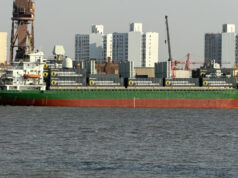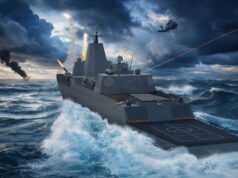The US Navy’s newest supercarrier, the USS Gerald R. Ford, may struggle to launch and recover aircraft, mount a defence and move munitions.
It has been reported that on-board systems for the previously mentioned tasks have poor or unknown reliability issues, according to a June the 28th memo obtained by Bloomberg News.
Michael Gilmore, the Defense Department’s director of operational test and evaluation, wrote:
“These four systems affect major areas of flight operations. Unless these issues are resolved, which would likely require redesigning, they will significantly limit the CVN-78’s ability to conduct combat operations.
Based on current reliability estimates, the CVN-78 is unlikely to conduct high-intensity flight operations at the outset of a war.”
In January 2014, the annual Director, Operational Test and Evaluation (DOT&E) report said that critical ship systems including the EMALS, Advanced Arresting Gear, Dual Band Radar, and weapons elevators were not reliable enough and needed more testing and improvements.
EMALS testing recorded 201 launch failures out of 1,967 launches, equaling a reliability rate of 240 mean cycles (launching of one aircraft) between critical failures. Testing of the Advanced Arresting Gear recorded 9 arresting failures out of 71 attempts, equaling a reliability rate of 20 mean cycles (recovery of one aircraft) between operational mission failure, a failure rate 248 times higher than should be expected.
Those systems performed at a fraction of their requirements for shipboard configurations, and even less of required standards. Radar and weapons elevator test data was not made available, but were also below expectations.
The US Navy maintains that further testing will resolve the problems.













Oh dear!
To be fair though testing is there for exactly this type of thing. It would be more worrying if this type of problem happened out in the field.
Exactly. One only has to look at the T45s to see where t sting may not have been as thorough as required for a vessel meant to operate around the globe.
If she sits on a field then they have a real problem!
Here all week…plenty more humour where that one came from 😉
Apparently the problem was that the EMALS technology wasn’t actually tested – at all – prior to being chucked into production. Hence the issues with the catapaults spontaneously going off half cocked chucking planes and pilots into the sea, etc.
Can you point me to any reference that reports about the EMALS system sponanteously activating and sending aircraft into the sea? I’d like to read about this issue, if it really exists.
Thanks.
So while there is scope for “testing in a live production environment” as some of us in IT would say this is literally more like “draw something up on the blackboard, do some mock ups on a computer THEN chuck it into a live production environment”!
Operative word: tests. Not surprised considering the amount of new and untested technology in her design.
Seems to take after her namesake!
EMALS is brand new – it would amazing if there weren’t teething problems with it in operational use.
Totally agree. Testing and evaluation is all about finding out the issues before deployment. This should be published as a benchmark of good project management.
First in class. First with EM catapult (which we decided to avoid on cost grounds) bound to be issues.
Ooops. Quite sure they shall sort it though, that’s was 4 years of sea trials are for. Got to put ours through there paces yet
Hi folks, we’re aware this is a common issue in the development of complex platforms however the news here is the severity of the issues to be resolved.
Prateek Mishra this.
Now I know why the MoD suddenly dropped EMALS like it was hot and switched back to the F35B and the ski-jump. EMALS simply not ready for full use yet and it would have probably pushed back the in service date for the QE class carriers by a couple of years.
At least now we can wait for EMALS to mature and fit it at a later date if we wanted…
Ours? Designed during socialist era, will need bringing up to normal standards as soon as they are afloat ?
No.
Will wait and see. Hope no, but.
Still, no.
just minor teething problems just look at the Nimitz class from the first to last how they have evolved, changes ober time, ford is a big leap but also a test bed for plenty of changes, just like anything it takes time to iron ourt bugs she will be a formidable item when shes fully oporastional
Darron Hadley
Yeah I was trying to read this earlier bud
it’s new! these things happen… it will only make it better in the long term.
Sky Price, Todd Miller, Ronnie Serrano, Ben Alameda, David Flora
You mean hi-tech “ships” have issues making “IOC” as well? Huh…
USS Gerald R Ford is a slightly different and larger version of the Nimitz class, you could say it is Nimitz Mark 3, they’ll get the EMALS system up and working
Looks like our decision not to go with cats and traps. Particually EMALS was a good one.
I’m glad to see we’re not the only ones that can f’ck it up.
dont mean they won’t add to it. Ships are somewhat like PC’s for example you can add or ditch something want or dont need. And if i remember correctly there was a carrier scrapped in the past year or two so it might be the replacement so it is just a gigantic Game of Trial and error.